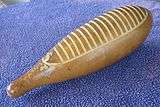Güiro
|
Modern fibreglass Cuban güiro | |
| Percussion instrument | |
|---|---|
| Other names | Rascador, güícharo, candungo, carracho, rayo |
| Classification | Idiophone, could be made from wood, gourd, metal, plastic or fiberglass |
| Hornbostel–Sachs classification |
112.23 (Scraped idiophone, vessel) |
| Playing range | |
| Speed of scrape produces some variation | |
| Related instruments | |
| Güira, guayo, guacharaca, reco-reco, quijada, washboard | |
 |
Modern Güiro
Sounds of the güiro |
| Problems playing this file? See media help. | |
The güiro (Spanish pronunciation: [ˈɡwiɾo]) is a Latin American percussion instrument consisting of an open-ended, hollow gourd with parallel notches cut in one side. It is played by rubbing a stick or tines along the notches to produce a ratchet sound.[1]
The güiro is commonly used in Puerto Rican, Cuban and other forms of Latin American music, and plays a key role in the typical rhythm section of important genres like son, trova and salsa. Playing the güiro usually requires both long and short sounds, made by scraping up and down in long or short strokes.[2]
The güiro, like the maracas, is often played by a singer. It is closely related to the Cuban guayo and the Dominican güira, which are made of metal. Other instruments similar to the güiro are the Colombian guacharaca, the Brazilian reco-reco, the quijada (cow jawbone) and the frottoir (washboard).[2]
Construction and design
The güiro, which was adapted from an instrument which might have originated in either South America or Africa,[2] is a notched, hollowed-out gourd.[3] The güiro is made by carving parallel circular stripes along the shorter section of the elongated gourd.
It is played by holding the güiro in the left hand with the thumb inserted into the back sound hole to keep the instrument in place. With the Brazilian güiro, after frictioning the springs it's possible to make use of the prolonged reverberation, or muffle them with the fingers. In some models, the box also has a bottom hole, allowing the musician to change the internal reverb by covering it or not.
Modern instruments found in Cuba now feature a square-shaped cut-out opposite of playing side in which to facilitate holding the instrument more comfortably.
Use in classical music
The güiro is used in classical music both to add Latin American flavor, and also purely for its instrumental qualities.
Examples of compositions including a güiro are Uirapurú by Heitor Villa-Lobos, Latin-American Symphonette by Morton Gould and Le Sacre du printemps by Stravinsky.[4]
Other meanings
In Regla de Ocha, a güiro is a musical performance and ceremony that uses shekeres, hoe blade, and at least one conga to accompany the religious songs of the Orishas.[5]
Gallery
-

Cuban güiro
-

Puerto Rican güiro or güícharo
-

Brazilian reco-reco
-

Güiro for children
-

Churuca panameña
See also
References
- ↑ Torres, George (2013). Encyclopedia of Latin American Popular Music. Santa Barbara, CA: Greenwood. p. 184.
- 1 2 3 Shepherd, John, ed. (2003). Continuum Encyclopedia of Popular Music of the World, Volume II: Performance and Production. London, UK: Continuum. pp. 372–373.
- ↑ Sue Steward (1 October 1999). Musica!: The Rhythm of Latin America - Salsa, Rumba, Merengue, and More. Chronicle Books. pp. 6–. ISBN 978-0-8118-2566-5. Retrieved 16 April 2013.
- ↑ Karl Peinkofer and Fritz Tannigel, Handbook of Percussion Instruments, (Mainz, Germany: Schott, 1976), 154.
- ↑ Caudillo, Diane Elizabeth. Prayers to the Orishas. A Look at Santeria. 2007
